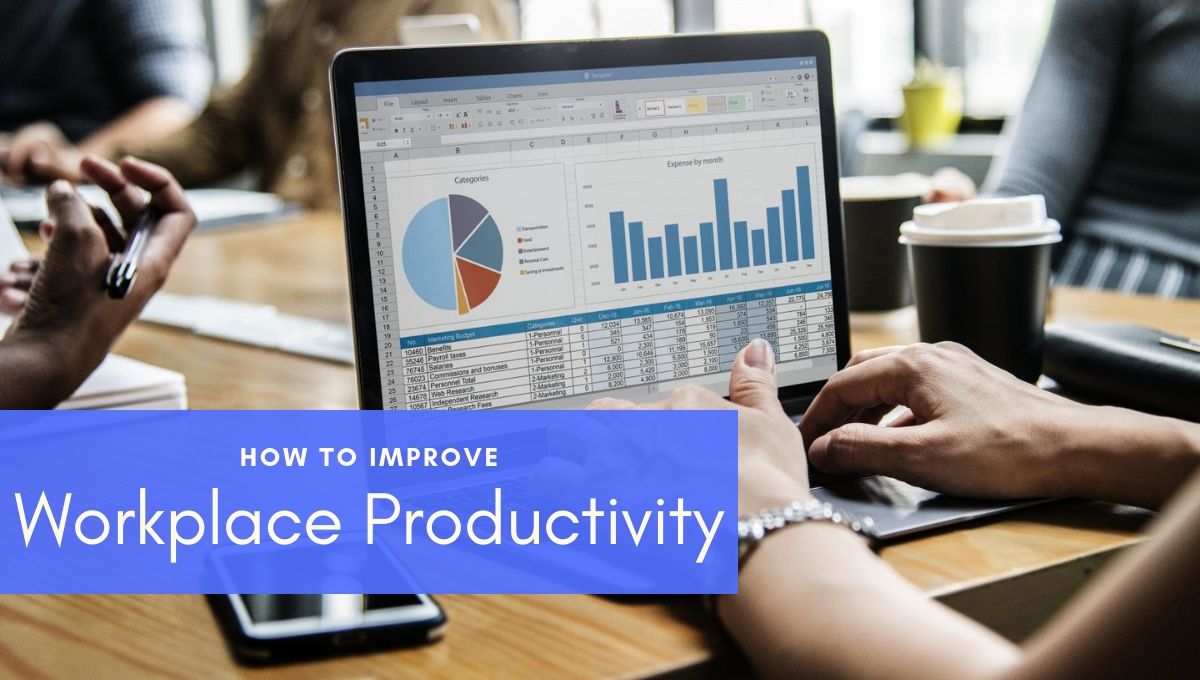There’s nothing more important to a business than its employees. But if your employees aren’t being productive in the workplace and living up to their full potential, then they will start to become quite a large expense.
Workplace productivity relates to how efficiently your workers accomplish tasks that help achieve your company’s goals. We want to show you how to improve your workplace productivity and get the most out of your employees. In this guide, we’re going to run through some of our top tips for engaging your employees and making your workplace more productive.
9 Ways to Increase Workplace Productivity:
1. Happiness is key:
Happy employees are an important part of a thriving, productive workplace. People leave businesses for any number of reasons, but the most common reason is that they are unhappy at work. This could be for a multitude of reasons:
- They feel the company is run by bad bosses or leaders
- Their day-to-day tasks are boring and unchallenged
- There have zero opportunities for career development in the business
- They receive little or no recognition for the work they do each day
- There is no workplace flexibility, which makes them feel like they’re more of a number than a valued employee
A great way to check that your employees are happy in the workplace is to send out regular employee engagement or happiness surveys. This will give you reliable data to gain a measure of employee happiness and identify what improvements you can make to help engage your workforce.
2. Manage your people well:
No one likes being micromanaged. And if you’ve ever been subject to micromanagement, you’ll know exactly why. This management style can lead to your employees feeling condescended, incompetent and insecure in their job role. It completely eliminates trust between a manager and their team. It might sound counter-intuitive, but one of the most effective ways to increase productivity is to have managers back off a little.
A good manager should coach their team, provide meaningful feedback and give their people autonomy. These managerial traits make a big difference to your employee’s happiness. Employees who are given some control over their work, such as managing their own time and making decisions on what they do and when they do it, tend to have greater job satisfaction and are therefore more productive. If employees feel like they have ownership over their own work, they will work harder to make sure it’s the best it can be. Manage less, and you’ll get better results.
3. Career Pathing:
For most employees, career development is the key to their engagement within the business. Spend time thinking consciously about how each employee should progress in their careers and make plans to help them develop new skills.
Employee retention is important to business success. Especially when it comes to your top talent and performers, you want to make sure that they stick around.
Set up regular 1:1s with your employees to find out where they see their careers going in the future if they want to learn any new skills and what you can do as a business or manager to make that happen.
It is also a good idea to educate employees on different types of career paths or job opportunities that are available to them within the business. This will stop them looking elsewhere if they know there are plenty of in-house opportunities to advance
4. Reward and Recognition:
Reward and recognition comes up time and time again in the world of HR and business. That’s because it’s very important in making sure your employees feel valued. Employees who receive appreciation for their good work are usually happier with their jobs and will be much more productive.
Recognizing the contributions employees make is hardly rocket science. But don’t forget, this is not just about a fair day’s pay. Praise and recognition are essential to creating a vibrant culture with happy, productive people. Some great ways to implement reward and recognition in your workplace are:
- Lunch clubs for high performers
- Income bonuses
- Memberships, gift cards or event tickets
- Company merchandise; water bottles, mugs, hats, t-shirts – anything that your MVP’s can wear around the office to show that they did something great
- Reward certificates or trophies for employees to showcase on their desk
- Time off; reward employees with a well-deserved ‘sleep-in day’; a paid-for day off for when they need that well-deserved downtime
- Peer-to-peer recognition
Reward and recognition incentives don’t need to cost your business the big bucks. Think outside the box for creative ways to reward your employees.
Top tip: Actually ask your employees what they want! Instead of spending money on incentives that just don’t do the trick, ask your employees what rewards they would appreciate receiving when they hit certain milestones in their job.
5. Invest in the right tools:
Investing in the right tools and providing your employees with the best means to perform their tasks efficiently and on time is a great way to boost workplace productivity. High-quality, modern programs and equipment make a HUGE difference to your workforce.
Your team’s skills are essential to business performance, but the tools they use in their work also play a big role. Choosing the right software will make their work easier and translates to a streamlined workflow. It’ll also help your employees feel less stressed out at work, as they can rely on the tools and tech to assist them on their ever-growing to-do list.
6. Invest in your employees:
As well as investing in all the latest tech tools, it’s important to invest in your employees as well. Investing and training your employees is a crucial step in ensuring workplace productivity.
Investing time and money into training your employees correctly will ensure that your employees feel valued and get a sense of progression in their job. This is a great way to keep employees engaged in business. No one wants to feel as if they’re in a dead-end job that’s taking them nowhere. Show your employees that you care about their career progression and want them to thrive.
Another benefit of investing in your employees is that the work they go on to produce will be of better quality if they’ve been put through the right training. So it’s win-win for both parties.
Ask your employees if there are any new skills they would like to learn or if there’s anything they would like to work on and improve. You can then start researching different ways to make that happen. Whether it’s an online course, regular shadowing sessions with someone from a different team or department or simply giving them time to do some independent studying.
7. Communicate:
Even the strongest of relationships can fall apart with bad communication – and it’s the same with businesses. Without effective communication, relationships end and businesses fail.
Managers who effectively communicate with clear expectations and responsibilities to their employees are rewarded with a more productive workforce and engaged employees. Make sure your communication with your team focus on the future of the business—instead of rehashing past issues or projects. If you demonstrate your commitment to moving forward in conversations with your employees, this will be reflected in the way they work. Ergo, making them more productive and driven to move forward, hit targets and smash through deadlines.
PSA: This does not mean you should just ignore past failures – these can be a huge learning exercise for your team and should be reviewed in detail. Doing a detailed postmortem on failed projects where you established exactly what you did, where you went wrong and what you would do differently next time will help your workers be more productive in the future. It will stop them making the same mistake twice. Looking at failures in this way is a much more positive, productive approach.
8. Employee Wellness:
Healthy, productive employees are the lifeblood of any company. You want to make sure your employees are feeling their best. Both mentally and physically. If they’re feeling great, they will have a more positive outlook, leading them to be much more productive.
You can look after your employee’s well being in multiple ways. Obviously, as soon as they step out of your workplace, you have little to no control over what they do. But what you can do, is make sure you’re looking after them whilst they are at work.
Some great ways to improve your employee’s wellness are by;
- Providing healthy snack options in the office. Giving your employees regular fresh fruit to eat throughout their working day will not only give them a natural sugar rush but also mean they’re getting at least one of their five a day.
- Make sure they take regular breaks. If an employee is working non-stop this can be bad for their mentality. It’ll lead to exhaustion and you’ll notice the quality of work won’t be the best. Make sure you monitor how regularly your employees are taking breaks.
- Keep your employees moving! This one does rely on having an employee wellness budget… but offering your employees exercise classes that they can go to during their lunch breaks or before or after work is a great way to tackle their mental and physical well being in one hit. Or you could set up lunchtime running clubs, walking meetups or free yoga sessions! Whatever it is that you’re employees are into.
- Invest in stand up desks. Stand up desks will help improve your employee’s posture and productivity. Prolonged sitting has been linked too many health risks (including obesity, heart disease, and diabetes) so standing up, even for a few hours each day can significantly help improve your employee’s health.
Exercise is not only important for the body, but it is also important for the mind. The food we eat is extremely important in boosting our brainpower and impacting how productive we are at work. So try to implement some initiatives into your workplace that will help your employees cover the basics and get them feeling fantastic!
9. Help set goals and priorities:
Making sure your employees have clear goals, daily tasks and priorities are important to make sure they’re being productive. There are a few ways to do this, but here are some of my favorites.
Each morning, or the beginning of a shift, huddle your team together for about 5-15 minutes and go over each team members main priorities of the day. Go through the one thing they have to get done that day, plus any smaller tasks. This will also help you understand the workload of each of your employees. You may then be able to delegate tasks to other employees with better skills or turn certain tasks into team projects, helping to get the tasks done quicker and more efficiently. It will also help the employees know exactly what needs to get done that day and gives them a commitment to stick to.
The first hour of every day is usually the most productive one. So make sure your employees are prioritizing either their most challenging or most important tasks at the beginning of the day so they have plenty of time to complete the task.
There you have it; ten simple steps that will help you to increase your workplace productivity by increasing employee happiness and engagement. Put these approaches into practice and watch your business skyrocket all the way to success.
Author bio: Megan Bonnett is currently working at Employment Hero. An HRIS that allows businesses to manage HR, payroll and employee benefits all in one place.
They are on a mission to make a better world at work for everyone.







































